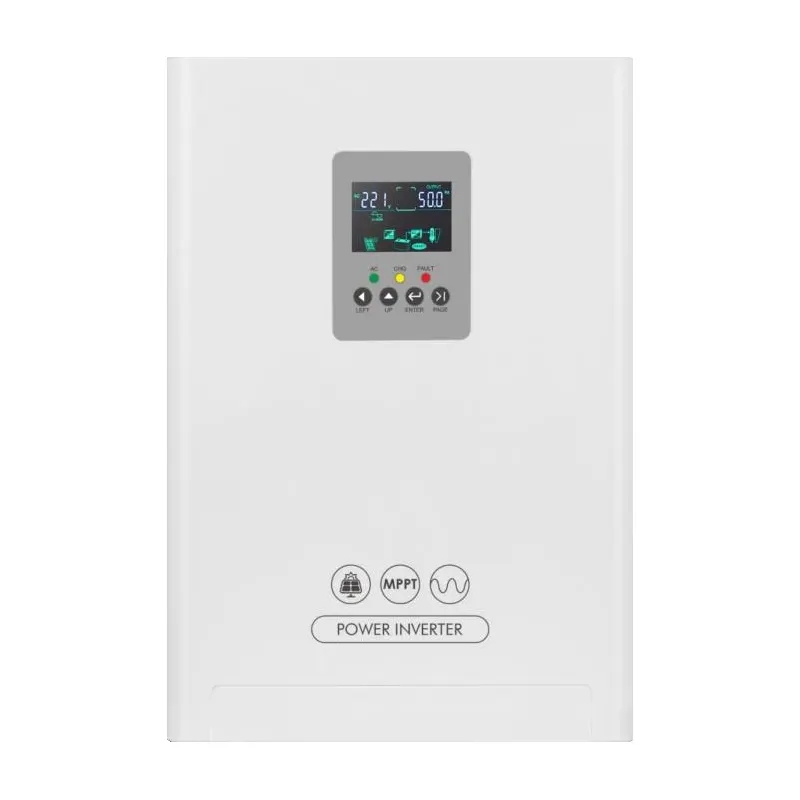 English
English Español
Español  Português
Português  русский
русский  Français
Français  日本語
日本語  Deutsch
Deutsch  tiếng Việt
tiếng Việt  Italiano
Italiano  Nederlands
Nederlands  ภาษาไทย
ภาษาไทย  Polski
Polski  한국어
한국어  Svenska
Svenska  magyar
magyar  Malay
Malay  বাংলা ভাষার
বাংলা ভাষার  Dansk
Dansk  Suomi
Suomi  हिन्दी
हिन्दी  Pilipino
Pilipino  Türkçe
Türkçe  Gaeilge
Gaeilge  العربية
العربية  Indonesia
Indonesia  Norsk
Norsk  تمل
تمل  český
český  ελληνικά
ελληνικά  український
український  Javanese
Javanese  فارسی
فارسی  தமிழ்
தமிழ்  తెలుగు
తెలుగు  नेपाली
नेपाली  Burmese
Burmese  български
български  ລາວ
ລາວ  Latine
Latine  Қазақша
Қазақша  Euskal
Euskal  Azərbaycan
Azərbaycan  Slovenský jazyk
Slovenský jazyk  Македонски
Македонски  Lietuvos
Lietuvos  Eesti Keel
Eesti Keel  Română
Română  Slovenski
Slovenski  मराठी
मराठी  Srpski језик
Srpski језик
Do you know all these inverters?
2024-04-09
The inverter is composed of three parts: inverter circuit, logic control circuit, and filter circuit. It mainly includes input interface, voltage starting circuit, MOS switch tube, PWM controller, DC conversion circuit, feedback circuit, LC oscillation and output circuit, and load. and other parts. The control circuit controls the operation of the entire system, the inverter circuit completes the function of converting DC power into AC power, and the filter circuit is used to filter out unnecessary signals. This is how the inverter works. The work of the inverter circuit can be further refined as follows: first, the oscillation circuit converts direct current into alternating current; secondly, the coil boosts the irregular alternating current into square wave alternating current; finally, rectification makes the alternating current change into sine wave alternating current through square wave. .
There are many ways to classify inverters. For example, according to the number of phases of the inverter's output AC voltage, it can be divided into single-phase inverters and three-phase inverters. Single phase consists of a live wire and a neutral wire. "Single" refers to any one of the three phases. The standard voltage between A-N, B-N, and C-N is 220V. Three phases are three live wires, represented by ABC. If there is only three-phase voltage, it is 380V, also called a three-phase triangle; if in addition to the three live wires there is a neutral line, the voltage will be 220V and 380V, that is, three-phase Phase star connection.Three-phase inverters can be divided into two types: three-in and three-out or single-in and three-out (220 in and 380 out). The former is a voltage stabilizing function, while the latter is a voltage boosting function and requires the function of a rectifier. Generally speaking, systems less than 5KW generally use single-phase systems, and systems greater than 5KW generally use three-phase systems.
Depending on whether it is used in a grid-connected system or an off-grid system, it can be divided into grid-connected inverters and off-grid inverters. The off-grid inverter can work independently after leaving the power grid. It is equivalent to an independent small power grid. It mainly controls its own voltage and is a voltage source. It can carry resistive-capacitive and motor-inductive loads, has fast response and anti-interference, strong adaptability and practicality. It is the first choice power supply product for power outage emergency power supply and outdoor power supply. Off-grid inverters generally need to be connected to batteries, because photovoltaic power generation is unstable and the load is also unstable. Batteries are needed to balance energy. When photovoltaic power generation is greater than the load, the excess energy charges the battery. When photovoltaic power generation is less than the load, Insufficient energy is provided by the battery.
Inverters are classified according to their applicable occasions and can be divided into centralized inverters, micro inverters and string inverters. Centralized inverter technology is that several parallel photovoltaic strings are connected to the DC input end of the same centralized inverter. Generally, the high-power ones use three-phase IGBT power modules, and the smaller-power ones use field-effect transistors and DSP. The conversion controller improves the quality of the generated power so that it is very close to a sine wave current. It is generally used in systems of large photovoltaic power stations (>10kW). The micro-inverter tracks the maximum power peak of each photovoltaic module individually, and then integrates it into the AC grid after inversion. The single capacity of micro-inverters is generally less than 1kW. Its advantage is that it can independently track and control the maximum power of each component, thereby improving the overall efficiency when encountering partial shading or component performance differences.In addition, micro-inverters only have a DC voltage of tens of volts and are all connected in parallel, which minimizes safety hazards. They are expensive and difficult to maintain after failure. The string inverter is based on the modular concept. Each photovoltaic string (1-5kw) passes through an inverter, has maximum power peak tracking at the DC end, and is connected in parallel to the grid at the AC end. It has become an international The most popular inverter on the market. Many large photovoltaic power plants use string inverters. The advantage is that it is not affected by module differences and shadows between strings, and at the same time reduces the mismatch between the optimal operating point of the photovoltaic module and the inverter, thereby increasing power generation. These technical advantages not only reduce system costs, but also increase system reliability. At the same time, the concept of "master-slave" is introduced between strings, so that when the power of a single string cannot make a single inverter work, the system can connect several groups of photovoltaic strings together to allow one or several of them to work. , thereby producing more electrical energy.
Daya Electric Group Co., Ltd. sells many types of inverters, including single-phase and three-phase, off-grid and grid-connected, wall-mounted and stacked, in various forms to meet the different needs of our customers because of high quality and preferential prices. Attracting many new and old customers to buy.




